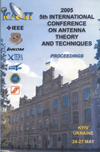17 Radio telescopes observing the Huygens signal coming from 1200.000.000 kilometer distance
DOI:
https://doi.org/10.1109/ICATT.2005.1496874Keywords:
radio telescope, antenna, VLBI, JIVEAbstract
The Huygens Probe landed 14 January 2005 on Titan, the largest moon of Saturn. During and after the landing, Huygens transmitted data to Cassini, which acted as data relay station flying nearby Titan. There were two transmission channels. One of the two channels was very stable in frequency: it was locked to an on-board ultra stabile oscillator (USO). Reception of its carrier signal of this transmission from Huygens has been possible with Earth-based radio telescopes at 1200.000.000 kilometre distance. Frequency stability permitted to process signals received at different radio telescopes with Very Long Baseline Interferometry (VLBI) techniques. Exploitation of the latter techniques permits to retrieve the Huygens trajectory through the Titan atmosphere and actual landing location with superb resolution. The scenario for the VLBI experiment is outlined, the direct signal reception at two large radio telescopes is indicated and related descriptive information is given. Post-processing of VLBI data is ongoing at the time of writing in Joint Institute for VLBI in Europe (JIVE). Good progress can be indicated.References
Various ESA press-releases, http://saturn.esa.int, http://saturn.jpl.nasa.gov, http://www.asi.it.
POPKEN, L. Modelling of Receiver Design Flaw - Crucial for Huygens Space Mission Recovery, Proc. of 2004 IEEE Aerospace Conf., 6-13 March 2004. IEEE, 2004, v.2, p.1408-1424, doi: http://dx.doi.org/10.1109/AERO.2004.1367742.
MIZZONI, R. Cassini High Gain Antenna. IEE Seminar on Spacecraft Antennas. London, 1994.
MARTIRANO, G.; ET AL. The Ku-band Subsystem of the Cassini High Gain Antenna. PIERS, July 1994, Noordwijk.
MUENCH, R.E.; SAGDEEV, R.Z.; JORDAN, J.F. Pathfinder: Accuracy improvement of comet Halley trajectory for Giotto navigation. Nature, May 15, 1986, v.321, p.318-320, doi: http://dx.doi.org/10.1038/321318a0.
Report 02/A30, ESA-General Study Program, http://esamultimedia.esa.int/docs/gsp/completed/comp_a_02_A30.pdf, see also JIVE research notes at http://www.jive/nl/docs/resnotes/resnotes.html.
Proc. of Conf. on Planetary Probe Atmospheric Entry and Descent Trajectory Analysis and Science, 6-9 Sept. 2003, SP-544, Lisbon. ESA, 2003.
http://www.nrao.edu/news/newsletters/nraonews103.pdf.
http://www.atnf.csiro.au/news/newsletter/feb05/, http://www.parkes.atnf.csiro.au/events/huygens_track/.
ASMAR, S. Eavesdropping on Huygens. Planetary Report, March 2005.
http://www.planetary.org/saturn/index.html.
WHITNEY, A.R. "Mark 5 Disc-based Gbps VLBI Data System" in New Technologies in VLBI [ed. by Y. C. Minh], ASP Conf. Series, 2003, v.306, p.123, http://web.haystack.mit.edu/mark5/paper.pdf.

